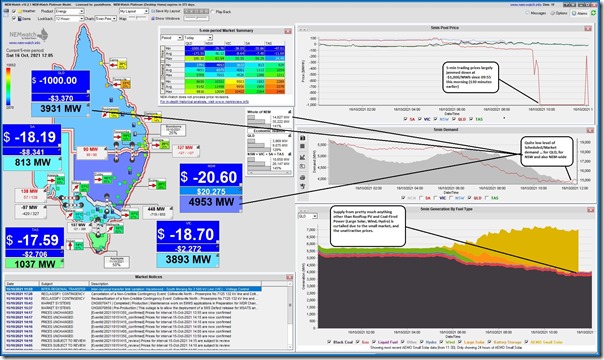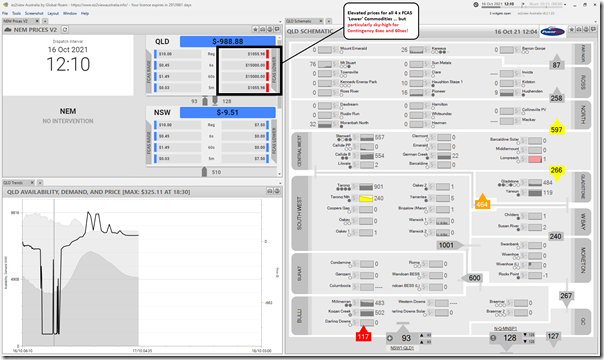With our envisaged (Monday 6th December) release date for GenInsights21 continuing to advance, today I am buried in some detailed analysis that will be accessible in that report later. However it was difficult to avoid noticing the ‘new normal’ scenario unfolding in the QLD region on this mild spring daylight period on Saturday 16th October 2021.
Here’s firstly a snapshot from our NEMwatch dashboard at 12:05 today, on which I have highlighted a couple things:
Check out how:
1) The new 5-minute trading prices have been jammed down at –$1,000/MWh since the 09:55 dispatch interval (except for one);
2) We’re not quite at record lows, but we can see that (apart from Tasmania) we have low demand in the NEM this spring Saturday:
(a) The NSW region is well down at the ‘deep blue’ end of the relative scaling for the ‘Total Demand’ measure (referred to as ‘Scheduled Demand’ and ‘Market Demand’).
Not quite down at the ‘lowest point’ record set NEM-wide on Sunday 3rd October 2021.
(b) The only reason that QLD is not a similar deep blue is because the historical range that the colour is set against was driven ‘artificially’ low following UFLS on Tuesday 25th May 2021 with the Callide C4 Catastrophe;
Even excluding that artificially-supressed benchmark, however, it’s not quite down at the low point set for QLD on Sunday 3rd October 2021.
(c) Also on a NEM-wide basis, the level is quite low in aggregate.
Not quite down at the ‘lowest point’ record set for NSW on Monday 4th October 2021.
3) All of this means that supply options have been squeezed, as a result of which:
(a) Almost all supply from Large Solar plant across QLD has curtailed via the dispatch process (as it belatedly needed to be from 12th April 2021, following this AEMC Final Determination), rather than consistently pay $1,000 per MWh for the pleasure of generating (no LGC is worth that much!)
(b) Same for the couple of Wind Farms in QLD.
(c) Only gas generators running are the ones with limited storage capability onsite.
(d) Hydro generators running, only when they have to for other reasons.
—
Here’s a snapshot from ez2view showing 3 different widgets that enables you to see more:
It’s important to remember that ‘ENERGY’ is not the only commodity that the AEMO co-optimises through the NEMDE dispatch process. Take a look at those massive prices for all four ‘Lower’ FCAS commodities … but particularly Contingency 6 second and Contingency 60 second.
It’s plain to see that Five Minute Settlement has not stopped prices down at –$1,000/MWh occurring (having looked to see change in bids from QLD coal generators recently, we can understand why).
Something more to ponder for the ‘early insights from 5MS’ appendix to be included in GenInsights21 … and also for the AIE discussion on Thursday 2nd December 2021.




Any idea how much the QLD tax payers lost on Saturday due to the poor management of the operation of the QLD Government owned generators?
Without knowing how much of that power is under contract it is difficult to determine, but operating at negative $1,000 per MWh for hours at a time must have cost millions of dollars.
It is actually a very clear case of market power abuse, with the near complete removal of all competing generators priced out of the market.
Would it not be more profitable for the State-owned generation companies to shut down one or more coal generation units until demand picks up in mid summer, and sell the coal on the spot market, which is now extremely high?